Abstract
BACKGROUND:
Few studies have examined the association of layperson characteristics with cardiopulmonary resuscitation (CPR) provision. Previous studies suggested provider characteristics, including age and gender, were associated with CPR quality, particularly chest compression (CC) depth. We sought to determine the association of subject characteristics, including age and gender with layperson CPR quality during an unannounced simulated CPR event. We hypothesized shallower CC depth in females, and older-aged subjects.
METHODS:
As part of a larger multicenter randomized controlled trial of CPR training for cardiac patients’ caregivers, CPR skills were assessed 6 months after training. We analyzed associations between subject characteristics and CC rate, CC depth and no-flow time. Each variable was analyzed independently; significant predictors determined via univariate analysis were assessed in a multivariate regression model.
RESULTS:
A total of 521 laypersons completed a 6-month CPR skills assessment and were included in the analysis. Mean age was 51.8±13.7 years, 75% were female, 57% were Caucasian. Overall, mean CC rate was 88.5±25.0 per minute, CC depth was 50.9±2.0 mm, and mean no-flow time was 15.9±2.7 sec/min. CC depth decreased significantly in subjects >62 years (P<0.001). Male subjects performed deeper CCs than female subjects (47.5±1.7 vs. 41.9±0.6, P<0.001).
CONCLUSION:
We found that layperson age >62 years and female gender are associated with shallower CC depth.
Keywords: Cardiac arrest, Cardiopulmonary resuscitation, Bystander, CPR quality, Layperson, Demographics
INTRODUCTION
Survival from out-of-hospital cardiac arrest (OHCA) in most communities in the US is less than 12% and is dependent on prompt, high-quality bystander cardiopulmonary resuscitation (CPR).[1,2] Investigations of simulated CPR provision have suggested that certain provider characteristics such as age and gender are associated with the quality of CPR performed.[3–6] However, such studies have found conflicting results regarding the effects of age and gender on CPR quality. A study by Neset et al[3,5] showed that those aged 50–76 years old could perform appropriate CPR for an extended period of time while another study found that those they categorized as “elderly” providers (>65 years) had decreased CPR quality compared to younger cohorts. Similarly, whether characteristics related to the gender of the CPR provider have an effect on the quality of CPR delivered has not been clearly determined.[4,7]
We hypothesized that chest compression (CC) depth would be less in older aged subjects and in females. Understanding differences in lay provider CPR based on specific provider characteristics could help instructors target education and practice sessions specific to those demographics to improve lay provider CPR quality.
METHODS
As an analysis of a larger prospective randomized controlled trial (RCT) examining CPR training strategies among family members of hospitalized patients with risk factors for cardiac arrest, we examined CPR quality [CC rate of 100 compressions per minute (cpm) and CC depth 50 millimeters (mm)] during a 6-month follow-up with an unannounced testing session to determine the association of provider characteristics with CPR quality.[8] A duration of six-month for follow-up testing has been established as a standard in previous studies.[9–12] Family members were randomized to receive either video self-instruction (VSI) CPR training (with hands-on CPR skills practice) or video-only CPR training (without hands-on CPR skills practice) as a part of the larger RCT. Subjects then performed an unannounced 6-month CPR skills follow-up test.
In the primary RCT subjects were enrolled at 8 hospitals within the Southeastern Pennsylvania region between February 2012 and January 2015. Subjects were instructed in hands-only CPR and performed follow-up testing between August 2012 through May 2015, as described in a previous study published by our group.[8,12] Subjects were enrolled at their respective hospitals and randomized to a CPR training strategy using the American Heart Association (AHA) Family and Friends VSI Kit (Laerdal Medical, Wappingers Falls, NY) either with practice on an inflatable manikin or without practice on an inflatable manikin (video-only). Subjects did not perform baseline CPR skills testing at the initial enrollment session.
This study was approved by the institutional review board of the University of Pennsylvania (Protocol #814676) and the institutional review boards with jurisdiction over the additional study sites: Crozer-Keystone Health System, Albert Einstein Healthcare Network, Temple University, and the Chester County Hospital and Health System.
For each subject, a 6-month follow-up date was calculated as 180 days after the initial training. Two weeks prior to the target date, the subject was called by a research associate; contact was attempted a minimum of five times. Each subject was scheduled for an in-person interview within ±7 days of the target date. Interviews were conducted at a private or semi-private location of the subjects’ choosing (e.g. in the home, at their place of employment). During the interview subjects were asked to perform 2 minutes of CPR on a skill reporter manikin (Laerdal SkillReporting Manikin, Laerdal Medical, Wappinger Falls, NY). Subjects were unaware of the skills check prior to the follow-up session to prevent subjects from reviewing their CPR training prior to the skills check. All subjects received a similar cardiac arrest scenario and were encouraged to “do whatever they would in a real situation.” No information or questions about CPR were answered by the research associates until after the scenario was completed.
CPR skills
CC rate and depth were recorded using the Laerdal skill reporter manikin (Laerdal SkillReporting Manikin, Laerdal Medical, Wappinger Falls, NY). Target CC rate was considered 100 compressions per minute (cpm) and adequate CC depth was considered 50 millimeters (mm) as specified in the AHA 2010 guidelines.[13] For the 2-minute skills check, a skill-reporting CPR manikin connected to a computerized interface was utilized without CPR feedback (Laerdal Medical, Wappinger Falls, NY). The CPR quality module recorded compression information including instantaneous rate and depth, inactive time, average rate and depth, and hand placement. Mean depth was calculated as a mean of all compressions delivered relative to the start point (0 mm). Mean rate was calculated by the skill reporting software using the instantaneous rate for each compression, excluding extended pauses in compression from the calculation. Data were downloaded from the skill-recording manikin and entered into the study database using the REDCap electronic data capture tool, hosted at the University of Pennsylvania.[14]
Body mass index (BMI)
BMI was calculated as weight in kilograms (kg) divided by height in meters squared. Subjects were categorized according to the World Health Organization classification as either: underweight (≤18.4 kg/m2), normal (18.5–25 kg/m2), overweight (25.1–29.9 kg/m2) or obese (≥30 kg/m2) based on their documented weight and height.
Statistical analysis
Data were analyzed using a standard statistical software package (STATA 12, Statacorp, College Station, TX). Demographic data were examined using a Pearson’s chi-squared test as appropriate for categorical variables, and a Student’s t-test for continuous variables. We assessed CC rate and depth by age (increasing by years), gender, race, education, and BMI in a univariate analysis. Our multivariate regression model assessed the mean difference of CC rate and depth, while controlling for potential confounders such as site of initial study enrollment, prior CPR training, relationship to the patient, and mode of teaching (VSI and video-only). We dichotomized gender by female and male. Race was categorized into three variables, white, black, and other. The education variable was categorized by schooling level including elementary, middle, high school, some college/vocational college, and graduate school.
RESULTS
Between August 2012 and May 2015, 521 laypersons from the primary RCT completed the 6-month CPR skills assessment (Figure 1) and were included in the study. Mean age was 51.8±13.7 years, 75% were female, 55% were Caucasian (Table 1). Overall, mean CC rate was 88.5±25.0 cpm, mean CC depth was 50.9±2.0 mm, and mean no-flow time was 15.9±2.7 seconds. When examining each CPR quality metric based on age, as age increased, CC depth decreased significantly in subjects aged>62 years (P<0.0001; Table 2, Figure 2). In a univariate analysis, there was no association of CC rate or no-flow time with age (P=NS, respectively). Male subjects performed deeper CCs than female subjects (47.5±1.7 vs. 41.9±0.6, P=0.000). When analyzed independently and controlling for other variables, BMI was not associated with any CPR quality metrics (data not shown).
Figure 1.
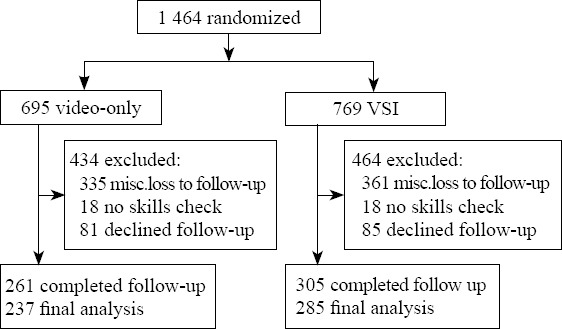
CONSORT diagram from primary RCT. Image taken from Blewer et al Circ Cardiovasc Qual Outcomes 2016.
Table 1.
Subject demographics (n=521)
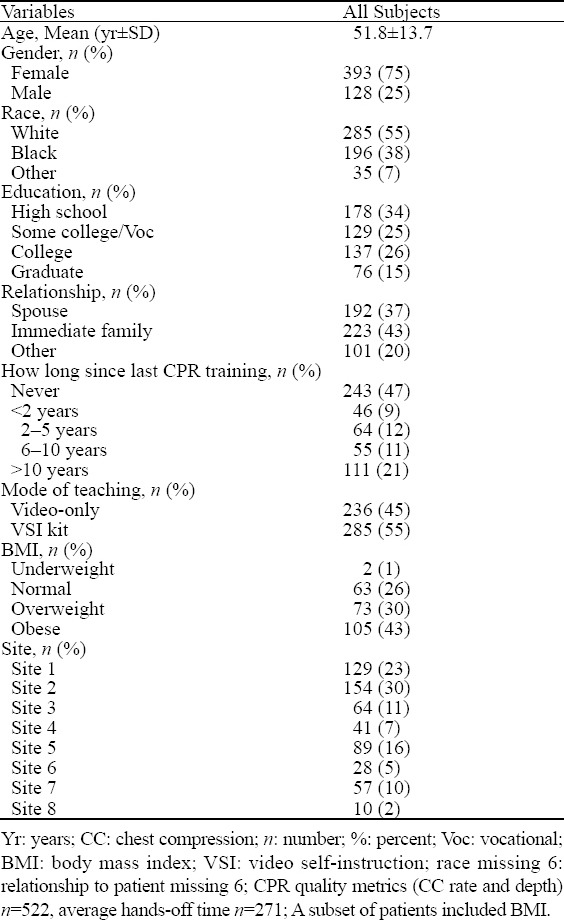
Table 2.
CPR quality metrics for total cohort (n=521)
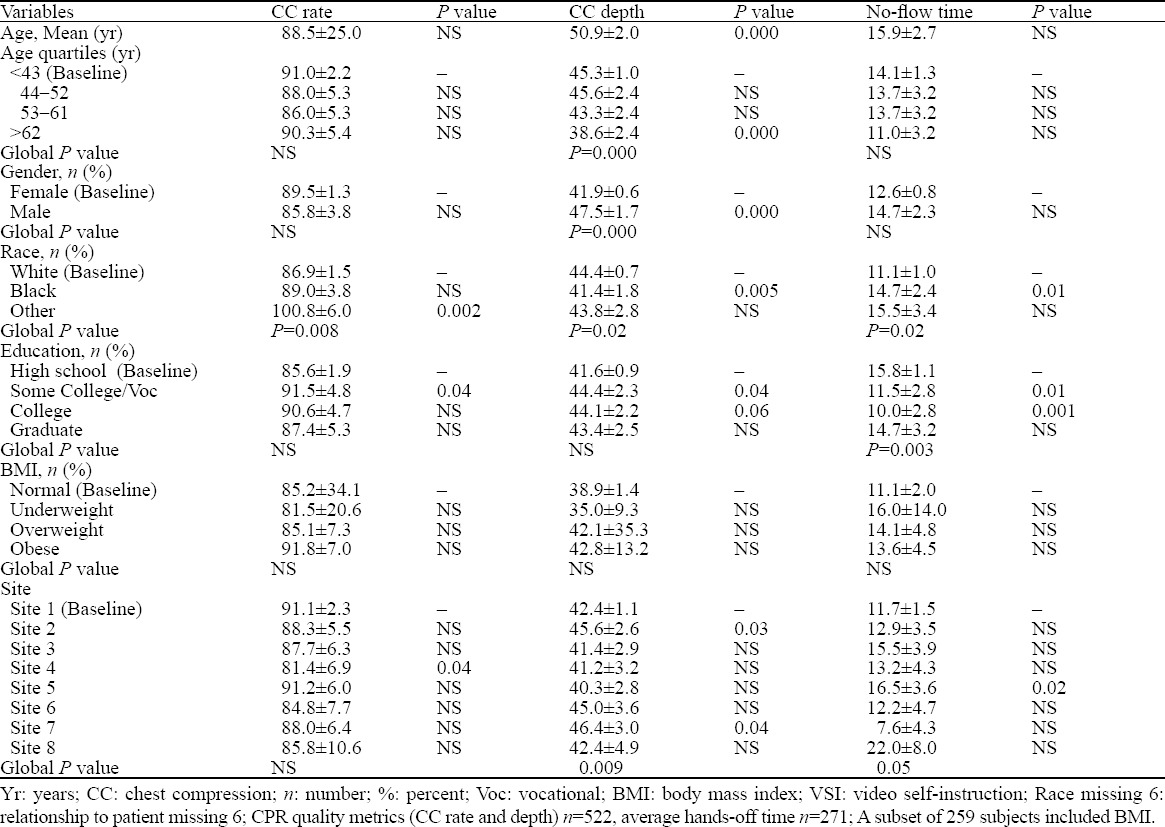
Figure 2.
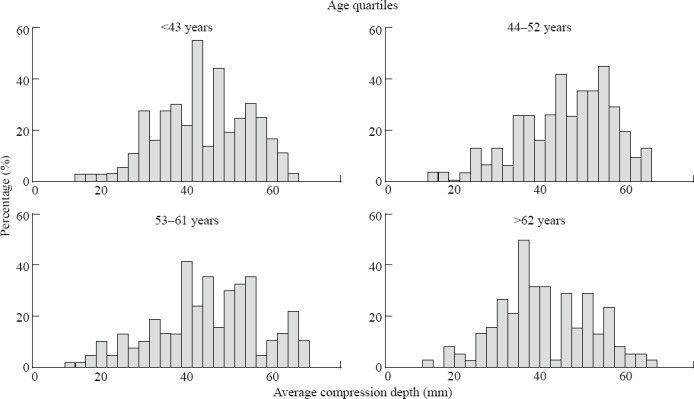
Chest compression depth and age.
In a multivariate regression analysis (Table 3) controlling for mode of teaching, site of enrollment and time since previous CPR training, we found that race had a statistically significant association with CC rate (P=0.014); age, gender, and race had a statistically significant association with CC depth (P<0.001, respectively); education level was associated with the duration of hands-off time (P=0.001).
Table 3.
Factors significantly associated with CPR quality in multivariate analysis
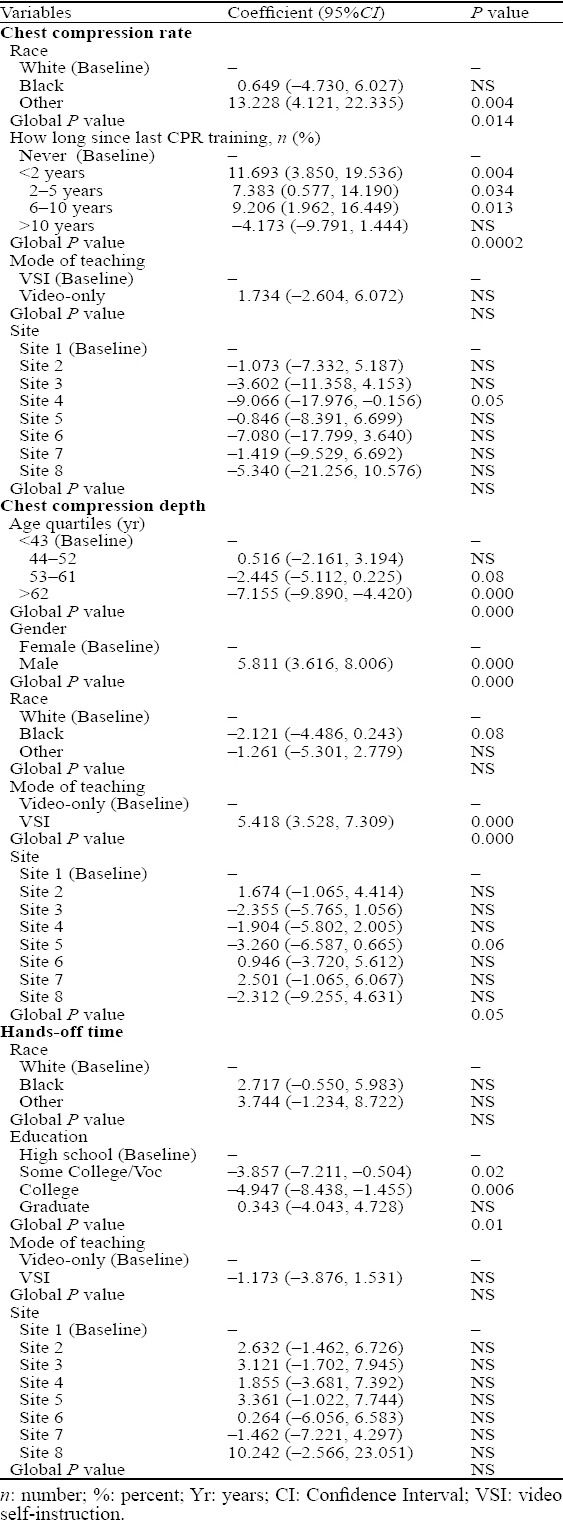
DISCUSSION
In this secondary analysis of a family member CPR training program, we showed that age and gender were associated with differences in CC quality during simulated CPR performance. As age increased, CC depth decreased significantly when subjects’ age was >62 years. Female subjects had a decreased CC depth compared to their male counterparts. We did not find any differences in BMI related to CC rate, CC depth or no flow time.
Other manikin studies have examined CPR quality related to gender and age.[15] Though we found that as our subjects’ age increased, those who were >62 years compressed at a significantly shallower depth, we did see a trend towards shallower depth when the age of our subjects was >52 years. A study by Papalexopoulou et al[6] reported that the retention of CPR skills decreases over time and similarly hypothesized that it may be due to the weakening of physical stamina with increasing age. As noted by Papalexopoulou et al,[3,6] other studies found that 50–76 year olds could perform CPR for an extended period of time in an acceptable range. In contrast, a study by Takei et al[5] found that the age of bystanders did affect the quality of CPR and showed that good quality bystander CPR was less often performed by “elderly” providers (>65 years). Our study showed that female gender and increasing age are associated with shallower CC depth.
When examining gender and CPR quality, López-González et al[16] examined college students (aged 19–43, mean 22.7±5.2 years) and reported on exertion rates. They found that women who performed CPR had higher exertion rates than their male counterparts. Though in our study we did not look at rates of physical exertion during CPR, we did find that the CC depth in our female population was significantly shallower compared to our male subjects. Performing deeper CCs could potentially lead to higher exertion rates and could account for our finding that female subjects compressed at a shallower depth than male subjects. López-González et al[16] noted however that the gender differences disappeared when they controlled for confounders. The authors concluded that there were no differences in terms of physical effort during CPR and that the differences were due to weight and physical fitness of their subjects. As BMI was similar in both female and male subjects in our cohort, this characteristic cannot account for the shallower depth by female compressors. A recently published study by Lin et al[7] examined pre-hospital provider specific factors that could affect CPR quality and did find that BMI, along with exercise, played a role in CPR quality. However, their study had a statistically significant difference in their subjects’ BMI, while our study did not find a difference between our subjects’ BMI.
These findings should be taken into consideration when structuring CPR training courses, as female CPR trainees may need to be instructed to push deeper than their male counterparts. Studies examining CPR quality during actual cardiac arrest events have shown that as CC rate increases, CC depth can decrease.[17–19] This could have been a factor in the findings that female subject compressed at a shallower depth while male subjects compressed at a deeper depth. Devices that quantify CPR quality and provide trainee feedback should be considered as studies have shown that CPR feedback devices can improve chest compression quality, and overall skill retention.[20–27]
Limitations
We acknowledge several limitations to this study. As this was a simulation study, whether CC rate and depth would be different between age and gender in laypersons when performing CPR on real cardiac arrest victims is unknown. Additionally, our cohort of subjects may not be generalizable to the public as the average age of our subjects who enrolled and demonstrated CPR performance was 51.8±13.7 years. An additional limitation we noted was a gender and racial imbalance as the majority of our population were female (75% female, 25% male) and white (55% vs. 38% and 7%). We did not record the number of subjects who declined enrollment in the study, and therefore we do not know if women or those classifying themselves as white agreed to participate in our study at a higher rate. However previous work from our group has shown that the characteristics of those who declined to enroll were similar to those who agreed to participate.[9]
CONCLUSIONS
We found that age >62 years and female gender are associated with shallower CC depth in CPR performed by laypersons. More work will need to be performed to determine whether these differences occur in actual cardiac arrest events and how to adapt CPR training to account for these differences.
Footnotes
Funding: NIH R18HL107217.
Ethical approval: This work is approved by the Institutional Review Board at the University of Pennsylvania.
Conflicts of interest: The authors declare there is no competing interest related to the study, authors, other individuals or organizations.
Contributors: Leary M proposed the study and wrote the first draft. All authors read and approved the final version of the paper.
REFERENCES
- 1.Chan PS, McNally B, Tang F, Kellermann A. CARES Surveillance Group. Recent trends in survival from out-of-hospital cardiac arrest in the United States. Circulation. 2014;130(21):1876–82. doi: 10.1161/CIRCULATIONAHA.114.009711. [DOI] [PMC free article] [PubMed] [Google Scholar]
- 2.Daya MR, Schmicker RH, Zive DM, Rea TD, Nichol G, Buick JE, et al. Resuscitation Outcomes Consortium Investigators. Out-of-hospital cardiac arrest survival improving over time:Results from the Resuscitation Outcomes Consortium (ROC) Resuscitation. 2015;91:108–15. doi: 10.1016/j.resuscitation.2015.02.003. [DOI] [PMC free article] [PubMed] [Google Scholar]
- 3.Neset A, Birkenes TS, Furunes T, Myklebust H, Mykletun RJ, Odegaard S, et al. A randomized trial on elderly laypersons’ CPR performance in a realistic cardiac arrest simulation. Acta Anaesthesiol Scand. 2012;56:124e131. doi: 10.1111/j.1399-6576.2011.02566.x. [DOI] [PubMed] [Google Scholar]
- 4.López-González Á, Sánchez-López M, Rovira-Gil E, González-García A, Ferrer-López V, Martínez-Vizcaíno V. Sex differences in the effort indicators during cardiopulmonary resuscitation manoeuvres on manikins. Eur J Emerg Med. 2015;22(1):62–5. doi: 10.1097/MEJ.0000000000000178. [DOI] [PubMed] [Google Scholar]
- 5.Takei Y, Nishi T, Matsubara H, Hashimoto M, Inaba H. Factors associated with quality of bystander CPR:the presence of multiple rescuers and bystander-initiated CPR without instruction. Resuscitation. 2014;85(4):492–8. doi: 10.1016/j.resuscitation.2013.12.019. [DOI] [PubMed] [Google Scholar]
- 6.Papalexopoulou K, Chalkias A, Dontas I, Pliatsika P, Giannakakos C, Papapanagiotou P, et al. Education and age affect skill acquisition and retention in lay rescuers after a European Resuscitation Council CPR/AED course. Heart Lung. 2014;43(1):66–71. doi: 10.1016/j.hrtlng.2013.09.008. [DOI] [PubMed] [Google Scholar]
- 7.Lin CC, Kuo CW, Ng CJ, Li WC, Weng YM, Chen JC. Rescuer factors predict high-quality cardiopulmonary resuscitation-a manikin-based study of health care providers. Am J Emerg Med. 2015 doi: 10.1016/j.ajem.2015.09.001. pii:S0735–6757(15)00741–X. [DOI] [PubMed] [Google Scholar]
- 8.Blewer AL, Putt ME, Becker LB, Riegel BJ, Li J, Leary M, et al. Video-only cardiopulmonary resuscitation education for high-risk families before hospital discharge:a multicenter pragmatic trial. Circ Cardiovasc Qual Outcomes. 2016 doi: 10.1161/CIRCOUTCOMES.116.002493. pii:CIRCOUTCOMES.116.002493. [Epub ahead of print] [DOI] [PMC free article] [PubMed] [Google Scholar]
- 9.Blewer AL, Leary M, Esposito EC, Gonzalez M, Riegel B, Bobrow BJ, et al. Continuous chest compression cardiopulmonary resuscitation training promotes rescuer self-confidence and increased secondary training:a hospital-based randomized controlled trial. Crit Care Med. 2012;40(3):787–92. doi: 10.1097/CCM.0b013e318236f2ca. [DOI] [PMC free article] [PubMed] [Google Scholar]
- 10.Dracup K, Doering LV, Moser DK, Evangelista L. Retention and use of cardiopulmonary resuscitation skills in parents of infants at risk for cardiopulmonary arrest. Pediatr Nurs. 1998;24(3):219–25. [PubMed] [Google Scholar]
- 11.Sharieff GQ, Hostetter S, Silva PD. Foster parents of medically fragile children can improve their BLS scores:results of a demonstration project. Pediatr Emerg Care. 2001;17(2):93–5. doi: 10.1097/00006565-200104000-00003. [DOI] [PubMed] [Google Scholar]
- 12.Ikeda DJ, Buckler DG, Li J, Agarwal AK, Di Taranti LJ, Kurtz J, et al. Dissemination of CPR video self-instruction materials to secondary trainees:results from a hospital-based CPR education trial. Resuscitation. 2016;100:45–50. doi: 10.1016/j.resuscitation.2015.12.016. [DOI] [PMC free article] [PubMed] [Google Scholar]
- 13.Berg RA, Hemphill R, Abella BS, Aufderheide TP, Cave DM, Hazinski MF, et al. Part 5:adult basic life support:2010 American Heart Association Guidelines for Cardiopulmonary Resuscitation and Emergency Cardiovascular Care. Circulation. 2010;122(18 Suppl 3):S685–705. doi: 10.1161/CIRCULATIONAHA.110.970939. [DOI] [PubMed] [Google Scholar]
- 14.Harris PA, Taylor R, Thielke R, Payne J, Gonzalez N, Conde JG. Research electronic data capture (REDCap) - A metadata-driven methodology and workflow process for providing translational research informatics support. J Biomed Inform. 2009;42(2):377–81. doi: 10.1016/j.jbi.2008.08.010. [DOI] [PMC free article] [PubMed] [Google Scholar]
- 15.Wang J, Zhuo CN, Zhang L, Gong YS, Yin CL, Li YQ. Performance of cardiopulmonary resuscitation during prolonged basic life support in military medical university students:A manikin study. World J Emerg Med. 2015;6(3):179–85. doi: 10.5847/wjem.j.1920-8642.2015.03.003. [DOI] [PMC free article] [PubMed] [Google Scholar]
- 16.López-González Á, Sánchez-López M, Rovira-Gil E, González-García A, Ferrer-López V, Martínez-Vizcaino V. Sex differences in the effort indicators during cardiopulmonary resuscitation manoeuvres on manikins. Eur J Emerg Med. 2015;22(1):62–5. doi: 10.1097/MEJ.0000000000000178. [DOI] [PubMed] [Google Scholar]
- 17.Meaney PA, Bobrow BJ, Mancini ME, Christenson J, de Caen AR, Bhanji F, et al. Cardiopulmonary resuscitation quality:[corrected] improving cardiac resuscitation outcomes both inside and outside the hospital:a consensus statement from the American Heart Association. Circulation. 2013;128(4):417–35. doi: 10.1161/CIR.0b013e31829d8654. [DOI] [PubMed] [Google Scholar]
- 18.Stiell IG, Brown SP, Nichol G, Cheskes S, Vaillancourt C, Callaway CW, et al. What is the optimal chest compression depth during out-of-hospital cardiac arrest resuscitation of adult patients? Circulation. 2014;130(22):1962–70. doi: 10.1161/CIRCULATIONAHA.114.008671. [DOI] [PubMed] [Google Scholar]
- 19.Idris AH, Guffey D, Pepe PE, Brown SP, Brooks SC, Callaway CW, et al. Resuscitation Outcomes Consortium Investigators. Chest compression rates and survival following out-of-hospital cardiac arrest. Crit Care Med. 2015;43(4):840–8. doi: 10.1097/CCM.0000000000000824. [DOI] [PubMed] [Google Scholar]
- 20.Pozner CN, Almozlino A, Elmer J, Poole S, McNamara D, Barash D. Cardiopulmonary resuscitation feedback improves the quality of chest compression provided by hospital health care professionals. Am J Emerg Med. 2011;29(6):618–25. doi: 10.1016/j.ajem.2010.01.008. [DOI] [PubMed] [Google Scholar]
- 21.Skorning M, Beckers SK, Brokmann JC, Rortgen D, Bergrath S, Veiser T, et al. New visual feedback device improves performance of chest compressions by professionals in simulated cardiac arrest. Resuscitation. 2010;81(1):53–8. doi: 10.1016/j.resuscitation.2009.10.005. [DOI] [PubMed] [Google Scholar]
- 22.Beckers SK, Skorning MH, Fries M, Bickenbach J, Beuerlein S, Derwall M, et al. CPREzy8482improves performance of external chest compressions in simulated cardiac arrest. Resuscitation. 2007;72(1):100–107. doi: 10.1016/j.resuscitation.2006.05.020. [DOI] [PubMed] [Google Scholar]
- 23.Choi HS, Lee DH, Kim CW, Kim SE, Oh JH. Peer-assisted learning to train high-school students to perform basic life-support. World J Emerg Med. 2015;6(3):186–90. doi: 10.5847/wjem.j.1920-8642.2015.03.004. [DOI] [PMC free article] [PubMed] [Google Scholar]
- 24.Krasteva V, Jekova I, Didon JP. An audiovisual feedback device for compression depth, rate and complete chest recoil can improve the CPR performance of lay persons during self-training on a manikin. Physiol Meas. 2011;32(6):687–699. doi: 10.1088/0967-3334/32/6/006. [DOI] [PubMed] [Google Scholar]
- 25.Wutzler A, Bannehr M, von Ulmenstein S, Loehr L, Förster J, Kühnle Y, et al. Performance of chest compressions with the use of a new audio–visual feedback device:A randomized manikin study in health care professionals. Resuscitation. 2015;87:81–5. doi: 10.1016/j.resuscitation.2014.10.004. [DOI] [PubMed] [Google Scholar]
- 26.Rodríguez-Venegas JC, Carmona-Jiménez F, Muñoz I, Palma-Padró P, Alonso S. The True-CPR device. A new way to give great quality CPR? Resuscitation. 2015;96(Suppl.1):69–70. [Google Scholar]
- 27.Yeung J, Meeks R, Edelson D, Gao F, Soar J, Perkins GD. The use of CPR feedback/prompt devices during training and CPR performance:A systematic review. Resuscitation. 2009;80(7):743–51. doi: 10.1016/j.resuscitation.2009.04.012. [DOI] [PubMed] [Google Scholar]


